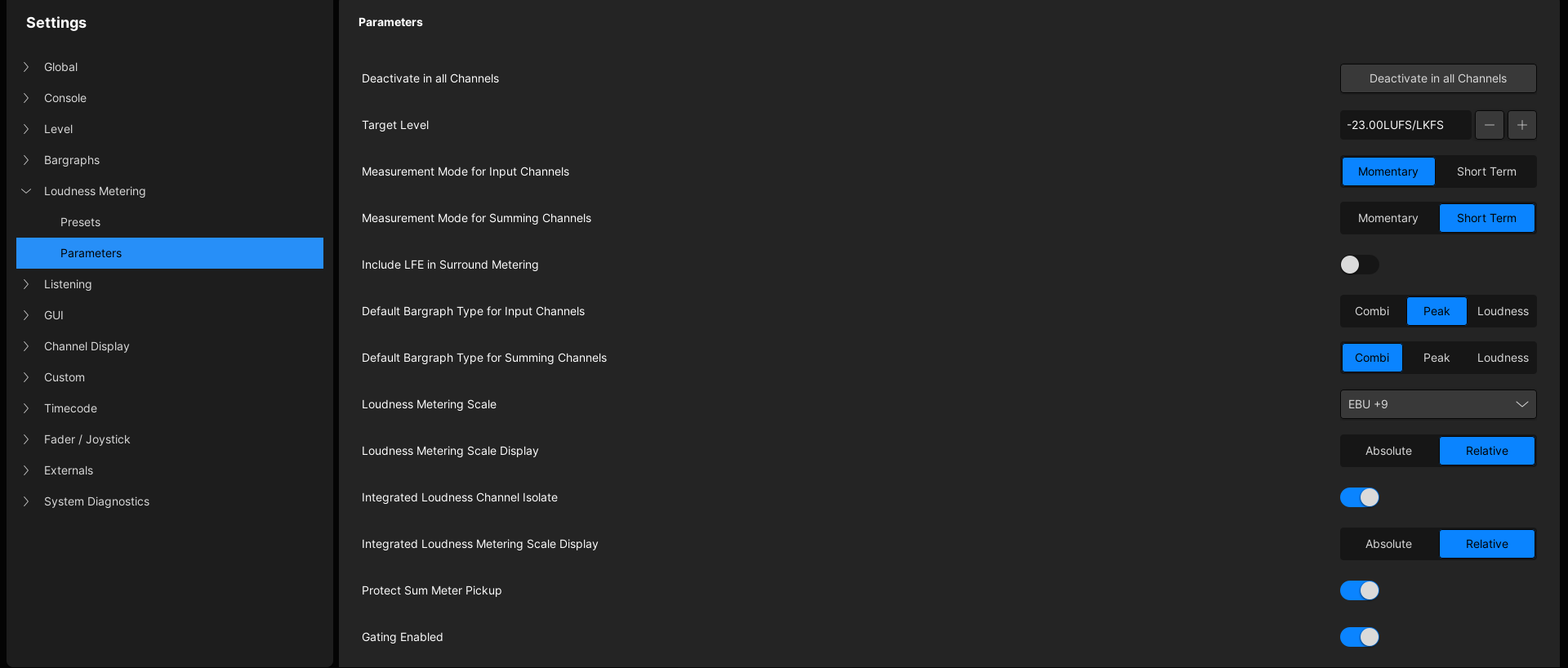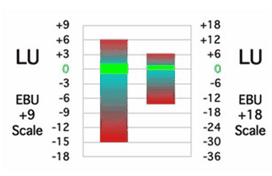mc²36 - System Settings -> Loudness Metering
The Loudness Metering options define the loudness metering measurements.
Loudness Metering → Presets
Active Preset
The Active Preset automatically recalls the correct loudness metering settings to comply with either the EBU R128 or ATSC A/85 & ARIB implementation standards.
The preset determines how loudness is displayed - in LU/LUFS for EBU R128, or LK/LKFS for ATSC/ARIB compliance. Note that LUFS is identical to LKFS defined by the ITU standard (BS 1770).
When you change the Active Preset, then the following parameters are reset:
- Target Level
- Loudness Metering Scale
- Gating Enabled & Relative Gating Threshold
Note that it is possible to edit these options manually if you wish to deviate from the EBU or ATSC/ARIB recommendations. In this instance, the Active Preset value changes to Custom.
Loudness Metering → Parameters

Deactivate in all Channels
Select this option to turn off loudness metering in all channels that support it.
Target Level
This option adjusts the target level for program loudness. It is set by the Active Preset as follows.
- The EBU R128 recommends a target level of 23 LUFS +/ 1 LU. The target level is equivalent to 0 LU on the EBU loudness metering scale.
- The ATSC A/85 & ARIB standards recommend a target level of 24 LKFS +/ 2 LK.
Note that LUFS is identical to LKFS defined by the ITU standard (BS 1770).
The value can be edited from -31 to -14 LUFS/LKFS. If you make a change, the Active Preset updates to Custom (to indicate a deviation from the EBU or ATSC/ARIB recommendations).
Measurement Mode for Input/Summing Channels
The next two options adjust the measurement mode for the loudness metering bargraphs. It can be set differently for input channels and summing channels (groups, auxes and sums). In each case, there are two possibilities:
- Momentary (M) – integration time operates over a 400ms sliding window.
- Short Term (S) – integration time operates over a 3 second sliding window.
The mode (M or S) is displayed in the loudness metering bargaphs.
Include LFE in Surround Metering
You can use this option to include or exclude the LFE channel in surround channel loudness measurements.
Default Bargraph Type for Input/Summing Channels
The next two options set the default mode for the channel meters. It can be set differently for input channels and summing channels (groups, auxes and sums). In each case, there are three possibilities:
- Peak – peak metering only.
- Combi – peak and loudness metering side by side.
- Loudness – loudness metering only.
Note that the meter mode can also be changed on an individual basis from the touch-screen (as described in mc²36 - Channel Display).
Loudness Metering Scale
This option defines the scale for the loudness meter bargraphs. The default scale is set by the Active Preset. In each case (EBU or ATSC), you can change between the standard and extended scales without affecting compliance.
For EBU R128 compliance, choose one of the following options:
|
EBU R128 Metering Scales |
For ATSC A/85 & ARIB compliance, choose one of the following options:
|
Loudness Metering Scale Display
This option determines how the loudness meter bargraph scale values are displayed. There are two possibilities:
- Absolute – scale values are displayed as absolute values in LUFS/LKFS.
- Relative – scale values are displayed relative to the Target Level.
Integrated Loudness Channel Isolate
This option affects channels using the integrated loudness measurement. It can be used to automatically isolate a channel (via SNAP ISO) once an integrated measurement is started. This prevents a snapshot load from turning off the loudness DSP module and, thereby, interrupting an active measurement.
Integrated Loudness Metering Scale Display
This option determines how the integrated loudness value is displayed. There are two possibilities:
- Absolute – value is displayed as an absolute value in LUFS/LKFS.
- Relative – value is displayed relative to the Target Level.
Protect Sum Meter Pickup
This option can be used to lock the position of the loudness DSP module in the signal flow for all summing channels (groups, auxes and sums).
Gating Enabled & Relative Gating Threshold
The next two options adjust the two-step gating for integrated loudness measurements. The values are set by the Active Preset.
The Gating Enabled option can be turned off or the Relative Gating Threshold can be adjusted (to either -8 or -10 LU/LK).
If you make any changes, the Active Preset updates to Custom (to indicate a deviation from the EBU or ATSC/ARIB recommendations).

